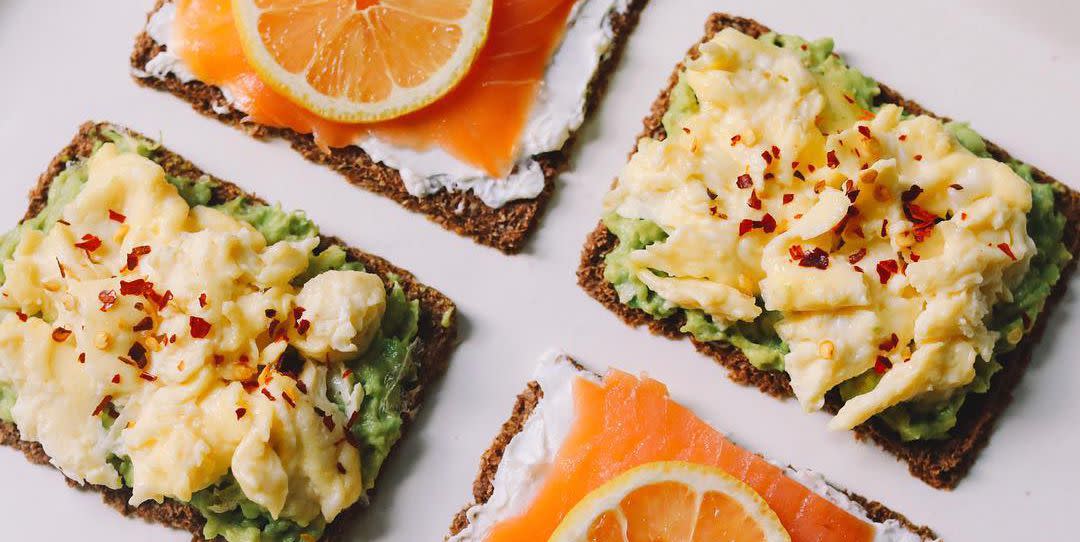The F-Factor Diet Is So Simple, It'll Make You Reconsider Going Keto

All it takes for a diet to blow up is a few celebrities to start buzzing about it. That's exactly what happened with the F-Factor diet after Megyn Kelly, Katie Couric, and Olivia Culpo raved about it. The diet first started getting buzz back in 2006 after dietitian and F-Factor founder Tanya Zuckerbrot published the book, The F-Factor Diet: Discover the Secret to Permanent Weight Loss.
Since then, plenty of people have jumped onto the F-Factor train. Maybe you've heard of it, maybe you haven't. If you're at all fuzzy on the details, we've got answers to your questions: What’s this all about again? And how does the whole thing actually work?
Here’s everything you need to know.
What is the F-Factor diet?
The diet is based on four principles that sound pretty great: Eat carbs, dine out, drink alcohol, work out less. Of course, it’s a little more nuanced than that. The diet specifically focuses on combining lean proteins with high-fiber carbohydrates that are low in calories and keep you feeling full.
A post shared by F-Factor™ by Tanya Zuckerbrot (@f_factor) on Apr 20, 2019 at 5:12am PDT
The diet was founded by registered dietitian Tanya Zuckerbrot, who has been in private practice in NYC for more than 20 years.
How does it work?
The “F” in F-Factor stands for “fiber,” and the diet is big on that. It recommends that women have at least 35 grams of fiber a day and that men have 38 or more grams of the stuff daily.
Fiber is a non-digestible carbohydrate, and “one of the most important dietary components associated with good health,” says Sonya Angelone, RD, a spokeswoman for the Academy of Nutrition and Dietetics. “For over 40 years, research studies have consistently shown that dietary fiber is associated with healthier cholesterol and blood sugar levels, is associated with less constipation and better bowel function, less colon cancer, and helps with weight management,” Angelone says.
Fiber also helps fill you up and stay satisfied, so eating plenty of it can help reduce hunger pangs many people experience on other diets, says New York-based registered dietitian Jessica Cording.
Meals include things like chicken cacciatore, zucchini parmesan waffles, and creamy mushroom asparagus risotto.
Is it healthy?
It definitely has the potential to be healthy if you approach it right. “This diet is most likely healthy if whole minimally processed foods are chosen,” she says. “The benefit comes from eating whole foods.” Cording agrees. Because the diet isn’t restrictive, it makes it more likely that people will stick with it. “Many people find it appealing that they can still enjoy carbohydrates and alcohol,” she says.
Why can it help me lose weight?
“Because this diet combines lean proteins with fiber-two nutrients that help you stay full-eating this way can help stave off those feelings of hunger that tend to creep up when someone is on a weight loss diet,” Cording says. And, on a mental level, following a diet that emphasizes adding more fiber instead of restricting what you eat “can help avoid putting forbidden foods on a pedestal that leads to fixation on those foods,” she says.
A post shared by F-Factor™ by Tanya Zuckerbrot (@f_factor) on May 22, 2019 at 5:58am PDT
High fiber foods also tend to be pretty healthy, and filling up on healthy foods can lead to weight loss. “High fiber foods are usually vegetables, fruits, whole grains, and legumes,” Angelone points out. “Foods with fiber are plants (since fiber gives plants structure) and have fewer calories per volume that fats and proteins.”
What can I eat?
There are a few different ways you can approach the diet. Plenty of people buy Zuckerbrot’s book and take it from there. There are lots of recipes on the F-Factor Diet’s website that you can use for inspiration, and Pinterest is packed with them, too.
Zuckerbrot also sells things on her website like F-Factor protein powder and protein bars, if you want to kick things up a notch. And, if you’re willing to shell out a little more money, you can make an appointment with Zuckerbrot or one of her fellow F-Factor dietitians to get one-on-one coaching.
A post shared by F-Factor™ by Tanya Zuckerbrot (@f_factor) on May 14, 2019 at 5:51am PDT
Do dietitians have any concerns about this?
Since the F-Factor diet is a high fiber diet, Cording just recommends stepping up your fiber intake gradually “to avoid digestive discomfort like gas, bloating, and abdominal discomfort.” It’s also a good idea to drink lots of water to keep things moving through your GI tract, she says.
The diet also doesn’t address portion and appetite control. “Some people are overweight because they eat even when full,” Angelone says. “They may not have hunger hormones that regulate appetite properly, they may eat mindlessly, and they may eat for emotional reasons. Just eating more fiber, which fills the stomach a bit more, may not be the answer for everyone’s weight issues.”
('You Might Also Like',)

